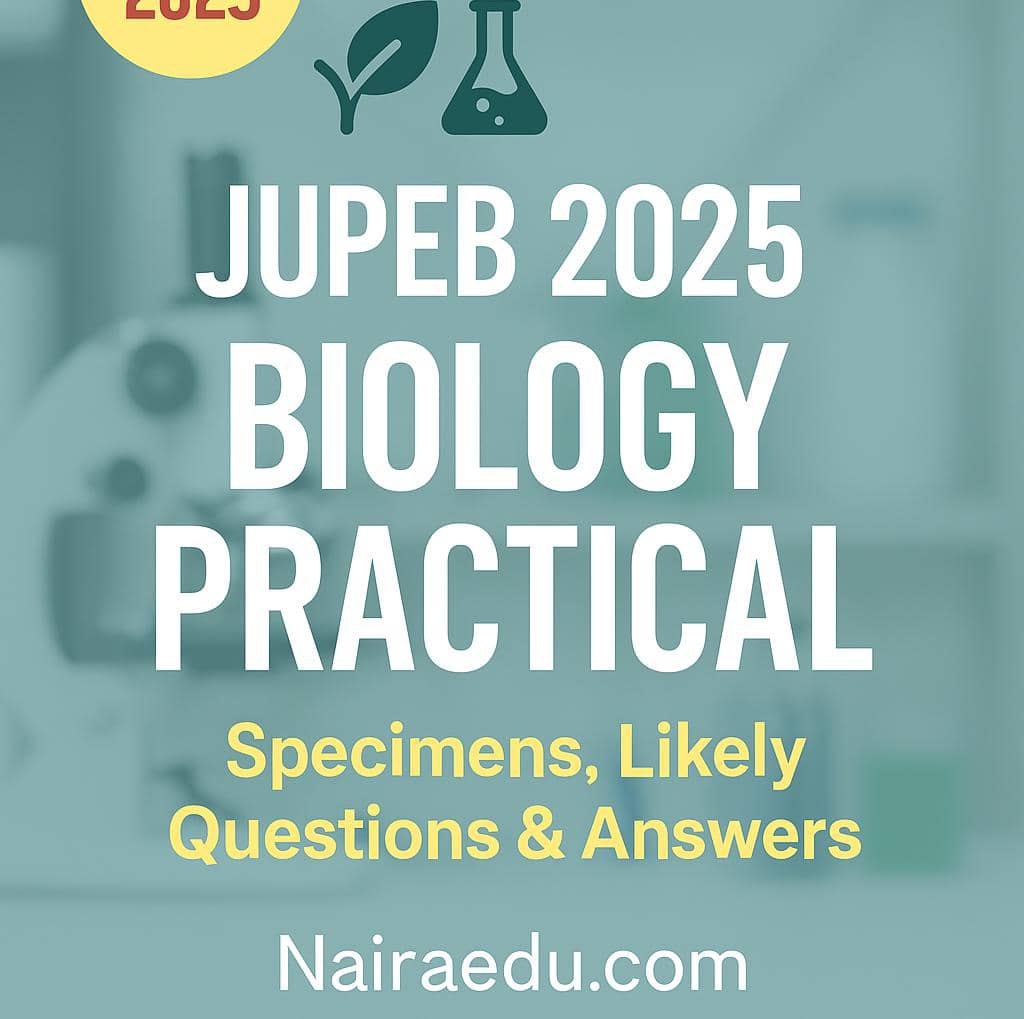The Joint Universities Preliminary Examinations Board (JUPEB) is an advanced level programme designed to help Nigerian students gain direct entry admission into 200 level at universities. One of the core subjects for science students is Biology, and the practical paper is a key part of the final assessment.
In the JUPEB Biology Practical exam, students are expected to observe, describe, draw, classify, and sometimes compare given biological specimens. Understanding the 2025 Biology Practical specimens ahead of the exam gives you a better chance to prepare smartly and score high marks.

In this post, we will:
- List out all the JUPEB Biology specimens 2025
- Predict possible questions that can come from each specimen
- Provide detailed answers, observations, and useful preparation tips
- Help you download JUPEB past questions for more practice
Whether you are studying alone or in a group, this guide is designed to make your practical exam easier to understand and pass.
JUPEB Biology Practical Specimens 2025
Below is the full list of Biology specimens for the 2025 JUPEB practical exam. These are the materials you will observe and work with during the practical:
| Specimen | Name | Type |
|---|---|---|
| A | Head of Cockroach with Antenna | Insect (Animalia) |
| B | Spider | Arachnid (Animalia) |
| C | Frog / Toad | Amphibian (Vertebrate) |
| D | Tomato | Fruit (Plant) |
| E | Mango | Fruit (Plant) |
| F | Groundnut | Seed (Dicot) |
| G | Maize Seed | Seed (Monocot) |
These specimens represent different biological categories including:
- Invertebrates and vertebrates (Cockroach, Spider, Frog)
- Fruits and seeds (Tomato, Mango, Groundnut, Maize)
Each of them is likely to be used to test your ability to:
- Identify and classify organisms
- Draw and label anatomical parts
- Compare features across specimens
- Describe functions and adaptations
JUPEB Biology Practical Likely Questions And Answers Based on the Specimens
Below are likely JUPEB Biology Practical 2025 questions and answers for each specimen based on past trends, examiner expectations, and WAEC/NECO style approaches. These questions focus on identification, classification, drawing, labelling, comparison, and function.
Specimen A – Head of Cockroach with Antenna
1. (a) Identify the specimen.
(b) Make a labelled diagram of the head of a cockroach.
(c) State two functions of the antenna.
(d) List two observable features that show this specimen is an insect.
Specimen B – Spider
2. (a) Identify the specimen.
(b) Draw and label the ventral (underside) view of the spider.
(c) Mention three differences between the spider and cockroach.
(d) State one economic importance of spiders.
Specimen C – Frog / Toad
3. (a) Identify the specimen.
(b) Classify the specimen under: Phylum, Class, Order
(c) State three observable features used to identify the specimen.
(d) What is the mode of locomotion of this specimen?
Specimen D – Tomato
4. (a) Identify the specimen.
(b) State the fruit type of the specimen.
(c) List three characteristics that make it a fruit.
(d) Mention one biological significance of the fruit.
Specimen E – Mango
5. (a) Identify the specimen.
(b) State two features used to recognize it.
(c) What type of fruit is mango botanically classified as?
(d) Differentiate between the mango and tomato fruits.
Specimen F – Groundnut
6. (a) Identify the specimen.
(b) Draw and label the longitudinal section of a groundnut seed.
(c) What type of seed is it (monocot/dicot)?
(d) State two economic uses of the specimen.
Specimen G – Maize Seed
7. (a) Identify the specimen.
(b) Draw and label the internal structure of a maize seed.
(c) Compare the maize and groundnut seeds using the table below:
(d) State one importance of maize in agriculture.
These questions are likely to test your understanding of external features, functions, classification, and diagrammatic representation.
Tips to Score High in JUPEB Biology Practical 2025
Scoring high in the JUPEB Biology Practical exam is not just about knowing the answers, it’s about understanding how to present your work properly. Follow these smart tips to boost your marks and avoid common mistakes.
1. Study Each Specimen Thoroughly
Before the exam, take time to:
- Observe real-life or clear pictures of each specimen (cockroach, spider, frog, tomato, etc.)
- Note key features such as number of legs, seed type, or body segments
- Understand their classification (phylum, class, order, etc.)
2. Practice Drawing and Labelling
You will likely be asked to draw one or two specimens. To do well:
- Use a sharp pencil (no pen) for diagrams
- Make your drawing neat and clear, not artistic
- Label at least 4–6 parts using straight horizontal lines
- Title every diagram (e.g., “Head of Cockroach”)
Tip: No shading. Label only what you can see clearly.
3. Answer Questions Using Scientific Terms
When describing features or functions, avoid casual words like “looks like this” or “it’s kind of round.” Instead, use proper biology terms like:
- Segmented body
- Antennae for sensory reception
- Dicot seed with two cotyledons”
4. Manage Your Time in the Exam Hall
You might be given 45–60 minutes for the entire practical. Plan it like this:
- First 10 minutes: Observe and identify specimens
- Next 30 minutes: Answer theory questions
- Last 15–20 minutes: Drawings and labelling
Keep your eye on the clock and avoid spending too much time on one question.
5. Practice with Past Questions
The more you practice JUPEB practical questions from past years, the better your confidence will grow. You will start to recognize patterns like:
- Repeated specimen types
- Similar comparison tables
- Common classification requests
6. Keep Your Work Neat and Organized
Presentation matters a lot in practicals. Make sure:
- Answers are written clearly with spacing
- Number all questions and sub-questions correctly
- Avoid cancellations, rough sketches, or untidy handwriting
7. Bonus Tip: Think Like a Biologist
Instead of memorizing blindly, ask yourself questions like:
- Why does this seed have two halves?
- How is this fruit adapted to seed dispersal?
- What is the difference between an insect and an arachnid?
This will help you understand instead of cramming, and that is what practical exams reward.
Conclusion
Preparing for the JUPEB Biology Practical 2025 doesn’t have to be stressful. With the official specimen list already released, you now have the opportunity to study ahead, understand each specimenspecimens function, and master likely questions before exam day.
RELATED POST
2025 JUPEB Examination Timetable
JUPEB Igbo Questions And Answers 2025
JUPEB Yoruba Questions And Answers 2025
See accredited universities in Nigeria that accept JUPEB for admission.
FAQ
What is the JUPEB Biology Practical all about?
The JUPEB Biology Practical is a hands on exam where students observe, draw, and describe given biological specimens. It tests your understanding of structure, function, classification, and scientific observation.
What are the confirmed JUPEB Biology Practical 2025 specimens?
The official specimens include: Head of cockroach with antenna, Spider, Frog or Toad, Tomato, Mango, Groundnut, and Maize seed.
Will I be asked to draw in the JUPEB practical?
Yes, drawing and correct labelling of specimens is a common part of the JUPEB Biology practical exam. You should practice clean, simple, and well-labelled diagrams.
Can I use past questions to prepare for the practical?
Absolutely. Past questions help you understand the format and likely questions. Downloading and studying past JUPEB practicals gives you an edge.
Where can I download JUPEB Biology Practical past questions?
You can download them directly from this blog post. Scroll up to find the link in the “Download” section or check our resources page.

Mr. Femi is an education blogger who simplifies exam updates and study tips for Nigerian students. His goal is to make learning smart, easy, and rewarding.


10 thoughts on “JUPEB Biology Practical Specimens 2025 and Likely Questions with Answers”